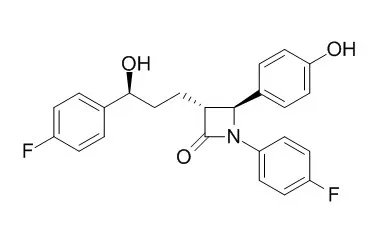| In vivo: |
| Am J Med. 2015 Feb;128(2):193-5. | | Ezetimibe use remains common among medical inpatients.[Pubmed: 25448168] | The US Food and Drug Administration licensed Ezetimibe in 2002 because of its ability to lower low-density lipoprotein cholesterol levels, a surrogate marker for the risk of coronary artery disease. The negative results of the Effect of Ezetimibe Plus Simvastatin Versus Simvastatin Alone on Atherosclerosis in the Carotid Artery trial were published in 2008. Since then, we have seen 6 additional years without a landmark study in favor of Ezetimibe. Furthermore, the new American Heart Association/American College of Cardiology guidelines (2013) now strongly downplay the use of nonstatin agents. We sought to determine whether Ezetimibe use remains common in 2014 using a new cohort that we have created to teach residents how to perform clinically relevant research.
METHODS AND RESULTS:
The McGill Teaching Unit Cohort is an anonymized prospective cohort study enrolling all patients admitted to the medical clinical teaching units of the Royal Victoria Hospital in Montréal, Québec, Canada, as of 2014. Information collected includes the receipt of cholesterol-lowering medications and other important demographics. Of the 783 patients enrolled on the date of analysis, 331 (42.7%) were receiving treatment for hypercholesterolemia. Of these, 156 (47%) were receiving primary prophylaxis. Overall, 323 patients (98%) were receiving a statin, 17 patients (5.1%) were receiving Ezetimibe, and 5 patients (1.5%) were receiving a fibrate. Users of Ezetimibe were more likely to be active smokers than nonusers (6/17 vs 42/314, P = .01); however, there were no other significant differences between important covariates or recent low-density lipoprotein measurements.
CONCLUSIONS:
Ezetimibe use remains common amongst medical inpatients despite a lack of evidence supporting its efficacy. | | Hepatology. 2015 Apr;61(4):1239-50. | | Ezetimibe for the treatment of nonalcoholic steatohepatitis: assessment by novel magnetic resonance imaging and magnetic resonance elastography in a randomized trial (MOZART trial).[Pubmed: 25482832] | Ezetimibe inhibits intestinal cholesterol absorption and lowers low-density lipoprotein cholesterol. Uncontrolled studies have suggested that it reduces liver fat as estimated by ultrasound in nonalcoholic steatohepatitis (NASH). Therefore, we aimed to examine the efficacy of Ezetimibe versus placebo in reducing liver fat by the magnetic resonance imaging-derived proton density-fat fraction (MRI-PDFF) and liver histology in patients with biopsy-proven NASH.
METHODS AND RESULTS:
In this randomized, double-blind, placebo-controlled trial, 50 patients with biopsy-proven NASH were randomized to either Ezetimibe 10 mg orally daily or placebo for 24 weeks. The primary outcome was a change in liver fat as measured by MRI-PDFF in colocalized regions of interest within each of the nine liver segments. Novel assessment by two-dimensional and three-dimensional magnetic resonance elastography was also performed. Ezetimibe was not significantly better than placebo at reducing liver fat as measured by MRI-PDFF (mean difference between the Ezetimibe and placebo arms -1.3%, P = 0.4). Compared to baseline, however, end-of-treatment MRI-PDFF was significantly lower in the Ezetimibe arm (15%-11.6%, P < 0.016) but not in the placebo arm (18.5%-16.4%, P = 0.15). There were no significant differences in histologic response rates, serum alanine aminotransferase and aspartate aminotransferase levels, or longitudinal changes in two-dimensional and three-dimensional magnetic resonance elastography-derived liver stiffness between the Ezetimibe and placebo arms. Compared to histologic nonresponders (25/35), histologic responders (10/35) had a significantly greater reduction in MRI-PDFF (-4.35 ± 4.9% versus -0.30 ± 4.1%, P < 0.019).
CONCLUSIONS:
Ezetimibe did not significantly reduce liver fat in NASH. This trial demonstrates the application of colocalization of MRI-PDFF-derived fat maps and magnetic resonance elastography-derived stiffness maps of the liver before and after treatment to noninvasively assess treatment response in NASH. | | Cardiovasc Ther. 2014 Oct;32(5):219-23. | | The effect of ezetimibe on androgen production in hypercholesterolemic women with polycystic ovary syndrome.[Pubmed: 25056604 ] | Statin therapy was found to reduce circulating androgen levels in patients with polycystic ovary syndrome (PCOS). No similar data are available for Ezetimibe.
METHODS AND RESULTS:
The study included 14 women with PCOS and hypercholesterolemia, intolerant to statins or having contraindications to this treatment, who were treated with Ezetimibe (10 mg daily). They were compared with 14 matched women with both of these disorders receiving simvastatin (40 mg daily). Plasma lipids, glucose homeostasis markers, and serum levels of androgens, sex hormone-binding globulin, and gonadotropins were assessed at baseline and after 3 months of treatment. Both simvastatin and Ezetimibe decreased plasma levels of total and LDL cholesterol. Ezetimibe, but not simvastatin, slightly reduced insulin resistance. Simvastatin decreased serum levels of total testosterone (-23%, P < 0.001), free testosterone (-32%, P < 0.001), androstendione (-20%, P < 0.01), and dehydroepiandrosterone sulfate (-17%, P < 0.05), as well as tended to reduce the luteinizing hormone/follicle-stimulating hormone ratio (-23%, P = 0.095). Ezetimibe only insignificantly reduced serum levels of free testosterone (-14%, P = 0.098). There were no differences in the effects of simvastatin on circulating hormone levels between insulin-resistant and insulin-sensitive subjects. In turn, the effect of Ezetimibe on free testosterone levels was stronger in insulin-resistant patients.
CONCLUSIONS:
Although Ezetimibe and simvastatin are equipotent in lowering lipid levels in hypercholesterolemic patients with coexisting PCOS, simvastatin exhibits a more pronounced effect on circulating androgen levels in this group of patients. |
|






 Cell. 2018 Jan 11;172(1-2):249-261.e12. doi: 10.1016/j.cell.2017.12.019.IF=36.216(2019)
Cell. 2018 Jan 11;172(1-2):249-261.e12. doi: 10.1016/j.cell.2017.12.019.IF=36.216(2019) Cell Metab. 2020 Mar 3;31(3):534-548.e5. doi: 10.1016/j.cmet.2020.01.002.IF=22.415(2019)
Cell Metab. 2020 Mar 3;31(3):534-548.e5. doi: 10.1016/j.cmet.2020.01.002.IF=22.415(2019) Mol Cell. 2017 Nov 16;68(4):673-685.e6. doi: 10.1016/j.molcel.2017.10.022.IF=14.548(2019)
Mol Cell. 2017 Nov 16;68(4):673-685.e6. doi: 10.1016/j.molcel.2017.10.022.IF=14.548(2019)